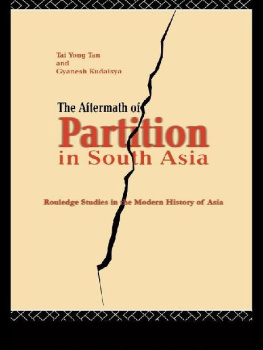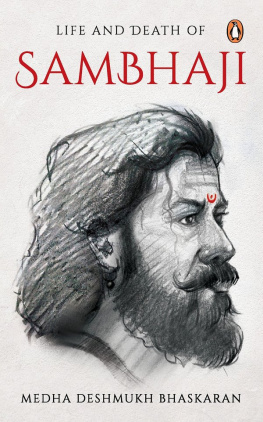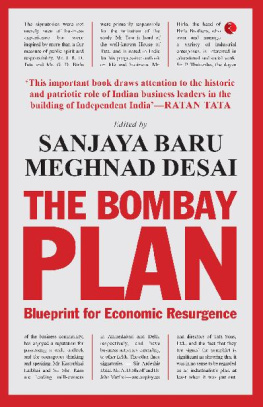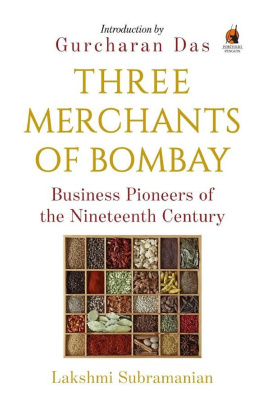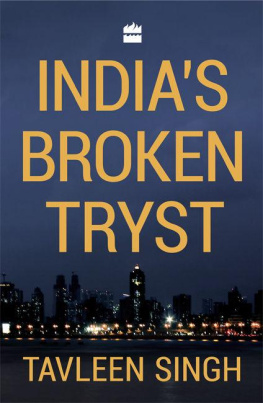Medha Malik Kudaisya - Tryst with Prosperity: Indian Business and the Bombay Plan of 1944
Here you can read online Medha Malik Kudaisya - Tryst with Prosperity: Indian Business and the Bombay Plan of 1944 full text of the book (entire story) in english for free. Download pdf and epub, get meaning, cover and reviews about this ebook. year: 2018, publisher: Penguin Random House India Private Limited, genre: Politics. Description of the work, (preface) as well as reviews are available. Best literature library LitArk.com created for fans of good reading and offers a wide selection of genres:
Romance novel
Science fiction
Adventure
Detective
Science
History
Home and family
Prose
Art
Politics
Computer
Non-fiction
Religion
Business
Children
Humor
Choose a favorite category and find really read worthwhile books. Enjoy immersion in the world of imagination, feel the emotions of the characters or learn something new for yourself, make an fascinating discovery.
- Book:Tryst with Prosperity: Indian Business and the Bombay Plan of 1944
- Author:
- Publisher:Penguin Random House India Private Limited
- Genre:
- Year:2018
- Rating:3 / 5
- Favourites:Add to favourites
- Your mark:
- 60
- 1
- 2
- 3
- 4
- 5
Tryst with Prosperity: Indian Business and the Bombay Plan of 1944: summary, description and annotation
We offer to read an annotation, description, summary or preface (depends on what the author of the book "Tryst with Prosperity: Indian Business and the Bombay Plan of 1944" wrote himself). If you haven't found the necessary information about the book — write in the comments, we will try to find it.
Tryst with Prosperity: Indian Business and the Bombay Plan of 1944 — read online for free the complete book (whole text) full work
Below is the text of the book, divided by pages. System saving the place of the last page read, allows you to conveniently read the book "Tryst with Prosperity: Indian Business and the Bombay Plan of 1944" online for free, without having to search again every time where you left off. Put a bookmark, and you can go to the page where you finished reading at any time.
Font size:
Interval:
Bookmark:


TRYST WITH PROSPERITY

PENGUIN BOOKS

PENGUIN BOOKS
PORTFOLIO
Medha M. Kudaisya is a business historian. She is an associate professor at the department of history, National University of Singapore. She has published widely on Indias business and economic history. Her publications include The Life and Times of G.D. Birla, Chinese and Indian Business: Historical Antecedents (co-edited with Ng Chin-keong) and The Oxford India Anthology of Business History (editor).
In this meticulously researched book Medha Kudaisya recreates the world of Indian business at its apex level in the 1940s. Drawing upon colonial records, newspapers and private papers of the key industrialists, Tryst with Prosperity brings alive the Bombay Plan of 1944. It argues with conviction that, as an economic blueprint for independent India, the Bombay Plan proposed a distinct path of capitalism with Indian characteristics, which would chart a middle path between state-led planning and private enterprise, enabling a creative partnership between the state and businessDwijendra Tripathi, eminent business historian
Tryst with Prosperity is the first systematic study of the Bombay Plan, a remarkable initiative by Indian business to contribute to development. With a readable and commanding narrative, the book shows the economic, political and intellectual backdrop to the Plan, and shows why the story still mattersTirthankar Roy, professor of economic history, London School of Economics
Arthashastra: The Science of Wealth by Thomas R. Trautmann
The World of the Tamil Merchant: Pioneers of International Trade by Kanakalatha Mukund
The Mouse Merchant: Money in Ancient India by Arshia Sattar
The East India Company: The Worlds Most Powerful Corporation by Tirthankar Roy
Caravans: Punjabi Khatri Merchants on the Silk Road by Scott C. Levi
Globalization before Its Time: The Gujarati Merchants from Kachchh by Chhaya Goswami (edited by Jaithirth Rao)
Three Merchants of Bombay: Business Pioneers of the Nineteenth Century by Lakshmi Subramanian
The Marwaris: From Jagat Seth to the Birlas by Thomas A. Timberg
Goras and Desis: Managing Agencies and the Making of Corporate India by Omkar Goswami
Indian Railways: Weaving of a National Tapestry by Bibek Debroy, Sanjay Chadha and Vidya Krishnamurthi
Planning and competition can be combined only by planning for competition, not by planning against competition. The planning against which all our criticism is directed is solely the planning against competition.
F.A. Hayek
Is Medha Kudaisyas account of the Bombay Plan a tryst with prosperity or is it a tryst with tragedy? As a professional historian, she has narrated the story with calm objectivity and equanimity, driven only by data and research, leaving the answer open to the reader. Her narrative begins with optimism in the middle of World War II when a group of highly competent, well-intentioned men with a proven record of success, came together to plan the economic future of India. It ends a decade later when the same men of high ideals are bitter and pessimisticthey realize that their plan has unwittingly produced the opposite of what they had intended. In the process of creating conditions for wiping out poverty in India, they had planted the seeds for a command economy and paved the way for what C. Rajagopalachari (Rajaji) called license, permit, inspector raj, thereby robbing the freedom of entrepreneurs and businessmen, the very persons who create jobs and wealth in a free society.
The ancient Greeks taught us that it is hard to blame anyone except fate when high tragedy strikes. So, I expect, is the case with the Bombay Plan and the subsequent ones that followed it in independent India. Neither the planners, nor Jawaharlal Nehru should be judged too harshly, for they were creatures of a socialist ageall victims of the zeitgeist, of the spirit of the times, as Ramachandra Guha puts it. Socialism was attractive to any sensitive person in those idealistic days. There was hope and the country was soon to become free. The class with money and influence was tiny and came entirely from the upper castes. It was natural for most Indians to expect that the government of free India should intervene on behalf of the masses; moreover, socialism had captured the imagination of the intelligentsia too. The leaders who had fought for decades for freedom were also in a hurry. They could not wait for the benefits to trickle down through a market-oriented strategy.
If it is hard to blame Nehru or the authors of the Bombay Plan, it is certainly possible to fault Indira Gandhi, Nehrus daughter, who ruled India after 1970. By then, there was plenty of evidence from the rise of East Asia that there existed a better, more successful model of development. Unlike Indias focus on heavy industry and import substitution, this model relied on the export of low-tech, labour-intensive manufactures. Despite being aware of it, Mrs Gandhi not only persisted with her fathers wrong model but went furthershe enacted more controls and tightened the Licence Raj. When individuals blunder, it is unfortunate and their families suffer. When rulers fail, it is a national tragedy.
Bombay Plan is the name commonly given to a set of proposals made by seven leading Indian industrialists and technocrats for the development of the post-independence economy of India. The industrialists were J.R.D. Tata, G.D. Birla, Sri Ram and Kasturbhai Lalbhai; the technocrats were A.D. Shroff, Ardeshir Dalal and John Matthai. Their plan laid out a comprehensive development agenda, arguing for rapid and self-reliant industrialization. They had a sensible goal of equitable growth and hoped to achieve it by doubling the per capita income in fifteen yearswith half the investment going to industry, which was expected to grow fivefold while the agricultural output would double during this period. They assumed that the economy could not grow rapidly without government actively setting up heavy industry via deficit financing, creating thus a sizeable public sector. They also believed that the fledgling private industry of the country would not be able to compete in a free-market economy and argued for protection from foreign competition in the early stages.
Although the industrialists recognized the need for foreign capital and technology, they felt it had to be under state control. They preferred foreign debt to foreign direct investment, and wanted foreign ownership to be prohibited in essential areas such as banking, insurance, power and aviation. Where it existed, they wanted it nationalized. They acceded to a vast area of state controlin fixing prices, limiting dividends, controlling foreign trade and foreign exchange, in licensing production, in allocating capital goods and distributing consumer goods. More ominously, they were willing to accept important limitations on the freedom of private enterprise, and felt that rights attached to private property would naturally be circumscribed.
Font size:
Interval:
Bookmark:
Similar books «Tryst with Prosperity: Indian Business and the Bombay Plan of 1944»
Look at similar books to Tryst with Prosperity: Indian Business and the Bombay Plan of 1944. We have selected literature similar in name and meaning in the hope of providing readers with more options to find new, interesting, not yet read works.
Discussion, reviews of the book Tryst with Prosperity: Indian Business and the Bombay Plan of 1944 and just readers' own opinions. Leave your comments, write what you think about the work, its meaning or the main characters. Specify what exactly you liked and what you didn't like, and why you think so.



